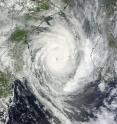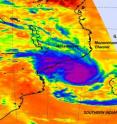Major Tropical Cyclone Funso analyzed by 2 NASA satellites
Related images
(click to enlarge)
Tropical Cyclone Funso is now a dangerous Category 4 cyclone in the Mozambique Channel, moving southward between Mozambique on the African mainland and the island nation of Madagascar. As Funso became a major cyclone two NASA satellites were providing forecasters with valuable storm information. Two instruments aboard NASA's Aqua satellite and instruments aboard NASA and JAXA's Tropical Rainfall Measuring Mission (TRMM) satellite provided cloud extent, cloud temperature, rainfall rates, and a look at the eye of the storm.
On Jan. 25 at 7:40 UTC (2:40 a.m. EST), the Moderate Resolution Imaging Spectroradiometer (MODIS) instrument on NASA's Aqua satellite captured a visible image of Tropical Cyclone Funso. The image revealed the cloud cover extends from Mozambique on the African mainland, east to the coast of the island nation of Madagascar. MODIS imagery also revealed a clear 11 mile-wide eye.
When NASA's Aqua satellite passed over Cyclone Funso the day before, January 24 at 11:17 UTC (6:17 a.m. EST) the Atmospheric Infrared Sounder (AIRS) instrument measured the cloud top temperatures. Thunderstorm cloud tops around the entire center of circulation colder than -63 Fahrenheit (-52.7 Celsius) indicating strong storms, dropping heavy rainfall.
The TRMM satellite also had a good view of powerful tropical cyclone Funso battering the Mozambique coast when it flew over on January 24, 2012 at 2204 UTC (5:04 p.m. EST). TRMM data showed that Funso was dropping moderate to heavy rainfall in bands covering the Mozambique Channel from eastern Mozambique to western Madagascar.
On January 25, 2012 at 0900 UTC (4 a.m. EST), Major Tropical Cyclone Funso had maximum sustained winds of 120 knots (138 mph/222 kph). Hurricane-force winds extend out 40 miles (64 km) from the center. It was located near 22.7 South and 38.7 East, about 400 nautical miles (460 miles/741 kmh) northeast of Maputo, Mozambique. It was moving to the south-southwest at 4 knots (~4.6 mph/7.4 kph). Funso is generating maximum significant waves 32 feet (9.7 meters) high.
Cyclone Funso continues to track the over open waters of the southern Mozambique Channel and forecasts take it out into the Southern Indian Ocean over the next three days without any danger of a direct landfall.
Source: NASA/Goddard Space Flight Center
Other sources
- NASA sees a weakening Cyclone Funso's 'closed eye'from PhysorgSat, 28 Jan 2012, 12:20:39 UTC
- NASA sees a weakening Cyclone Funso's 'closed eye'from Science DailySat, 28 Jan 2012, 0:30:24 UTC
- NASA satellites see cyclone Funso exiting Mozambique Channelfrom Science DailyFri, 27 Jan 2012, 4:30:16 UTC
- NASA satellites see cyclone Funso exiting Mozambique Channelfrom PhysorgThu, 26 Jan 2012, 22:30:42 UTC
- Major Tropical Cyclone Funso analyzed by 2 NASA satellitesfrom Science DailyWed, 25 Jan 2012, 22:30:28 UTC
- Major Tropical Cyclone Funso analyzed by two NASA satellitesfrom PhysorgWed, 25 Jan 2012, 22:30:24 UTC


